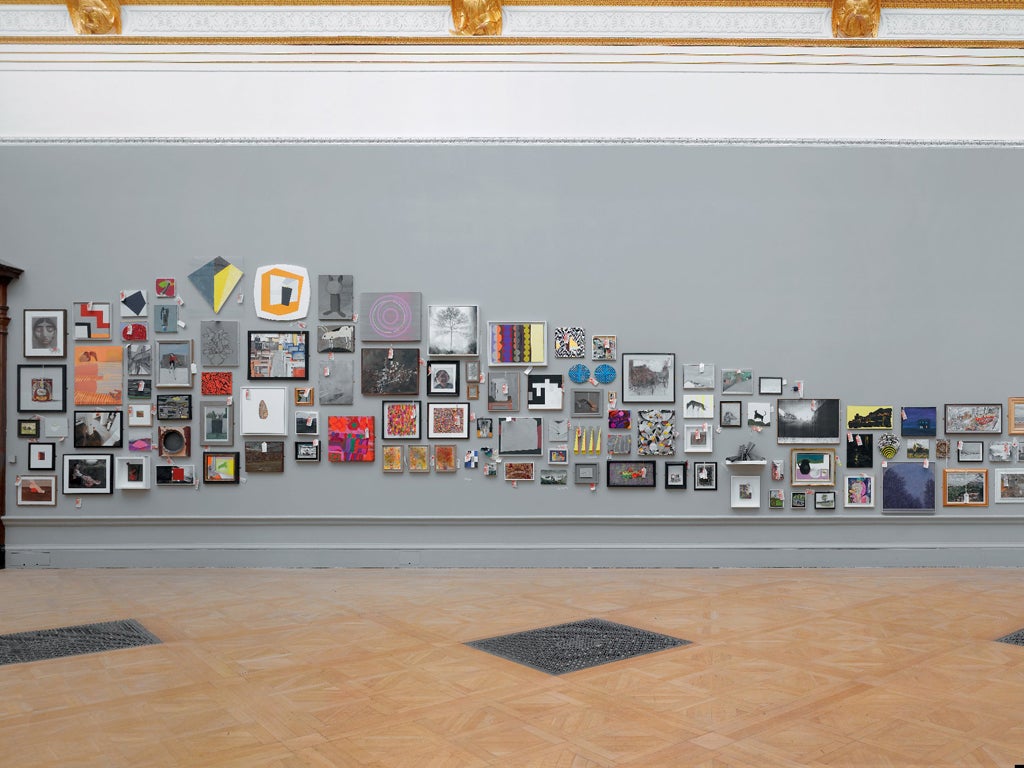RA Summer Exhibition, Royal Academy, London
Young blood and a fresh hanging policy at the Royal Academy kick-start a show traditionally immobilised by portraits of tabbies

Your support helps us to tell the story
This election is still a dead heat, according to most polls. In a fight with such wafer-thin margins, we need reporters on the ground talking to the people Trump and Harris are courting. Your support allows us to keep sending journalists to the story.
The Independent is trusted by 27 million Americans from across the entire political spectrum every month. Unlike many other quality news outlets, we choose not to lock you out of our reporting and analysis with paywalls. But quality journalism must still be paid for.
Help us keep bring these critical stories to light. Your support makes all the difference.
Small pictures in Room III? Something wrong there, surely. This is the Royal Academy Summer Exhibition. Room III is big: everyone knows that means big pictures. And the walls, they're ... grey. It's just not an Academy Colour. Maroon, yes; at a stretch, bottle green. But grey? Sorry.
The pictures aren't hung floor to ceiling either, as summer shows have been since 1768. They're strung out on a curved line, thrown around the room like debris on a stormy sea. "Here's a nice little one, A Street Scene in Bath," breathes a chiffonned matron, her voice clouded with doubt. She pronounces the last word "Bawth". Not everything has changed at Burlington House.
The hang of this year's summer show was co-ordinated by Tess Jaray, an Academician and geometric abstract painter. On the far wall of Room III is a small, two-part work by Jaray called After Malevich. Her diptych is compelling, poised and exact and yet sensuous at the same time. The brilliance of Jaray's work is in its feel for the balance between sum and parts, which accounts, I suppose, for her hang in Room III. Sadly, not all its parts were painted by Jaray.
As in any other Summer Exhibition, it's a mixed bag. There is a great deal of dreck: wordcount and kindness forbid my saying more. There's a lot of adequately proficient, mildly interesting work, perhaps half of everything on the Academy's walls. And then there are the few pictures that stand out, as there would be in 1,500 images chosen from 12,000 submissions.
After Malevich apart, many of the arresting works in this year's Summer Show are abstract. That's good. Somewhere along the line, abstraction went missing in British painting. In Jaray's rooms, it emerges again, blinking like a prisoner in Fidelio.
There are all kinds of abstractions here, of different stamps and intents. Hearteningly, some of the best works are by young painters: if I'd had the money and someone else hadn't got to it first, I'd have bought For an Eye by Alice Browne, 25, without blinking. Alas, I hadn't, and they had. David Batchelor's 28.03.11 shows that his genius for colour saturations takes in paint as well as light boxes. Why is Work No. 1353, a ziggurat of three brush-swipes by Jaray's ex-student, Martin Creed, so funny? I don't know, but it is.
I could go on, so I will. Terra Incognita and Red with Shadow place Colette Morey de Morand and Onya McCausland at the top of their respective games, even if they play abstraction by quite different rules. I had never heard of William Stein, although his engagingly neurotic Nerves – oil, scratchy pencil and copper leaf on gesso – makes me know I will again. Nathaniel Rackowe, best known for big, architecty sculptural installations, can handle two dimensions just as fluently as three: his London, 17, excremental tar on an acid yellow panel, stays in the mind. Works on paper? How about John Carter RA's Unfolding Planes in Yellow, or, if you're a Turner Prize groupie, Tomma Abts' Untitled #05?
Presumably Jaray's hand is behind another shocking departure in this year's Summer Exhibition, the giving over of an entire gallery to one film. In recent years, the Small Weston Room has been used as a dumping ground for the kind of pictures – watercolours of rubber plants, tabbies, St Mark's Square at Dusk – that dog the Academy's efforts to make its summer show less embarrassing. Jayne Parker's wonderful Trilogy: Kettle's Yard does that all by itself.
On screen, a cellist's hand draws a bow across strings. The instrument's body is scratched, gouged: the lines have the feel of incisions in paint. Something about Parker's shot – the cropping-out of all unnecessary information, its head-on angle – gives the image a painterly feel. As the hand saws away, you have the sense of a canvas come to life, of hearing a painting – a Braque, an early Ben Nicholson? – as well as seeing it. It is magical.
Visitors think so too. I go back to the Small Weston Room several times during my visit and every seat is taken, the audience sitting through all three pieces in Parker's 25-minute trilogy. They don't look like the kind of people who regularly see art films, but then they don't look like people who are asked to. Suddenly, for the first time, the Summer Exhibition seems relevant, as though it might have a greater role than merely giving visitors what they think they want to see. Long may it last.
To 12 Aug (020-7300 8000)
Critic's Choice
She has come home: Tracey Emin shines when exhibited at the Turner Contemporary in her home town of Margate. The show's title, She Lay Down Deep Beneath the Sea, is right for a coastal setting (to 23 Sep). At the Gagosian in London, see Henry Moore's Late Large Forms anew, within four walls instead of their usual sculpture park/plaza homes (to 18 Aug).
Join our commenting forum
Join thought-provoking conversations, follow other Independent readers and see their replies
Comments